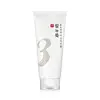What's inside
What's inside
 Key Ingredients
Key Ingredients

 Benefits
Benefits

 Concerns
Concerns

 Ingredients Side-by-side
Ingredients Side-by-side

Glycerin
HumectantWater
Skin ConditioningCellulose
AbsorbentSodium Cocoyl Glycinate
CleansingSodium Lauroyl Glutamate
Kaolin
AbrasiveDisodium Cocoamphodiacetate
Cleansing1,2-Hexanediol
Skin ConditioningHydrated Silica
AbrasiveLauryl Betaine
CleansingSodium Chloride
MaskingSodium Methyl Cocoyl Taurate
CleansingHydroxyacetophenone
AntioxidantEthylhexylglycerin
Skin ConditioningAcrylates/C10-30 Alkyl Acrylate Crosspolymer
Emulsion StabilisingCitric Acid
BufferingPolyglycerin-3
HumectantHexylene Glycol
EmulsifyingButylene Glycol
HumectantHydrogenated Lecithin
EmulsifyingFicus Carica Fruit Extract
HumectantCentella Asiatica Extract
CleansingBeta-Glucan
Skin ConditioningCeramide NP
Skin ConditioningCarbomer
Emulsion StabilisingHydroxypropyl Starch Phosphate
Glycerin, Water, Cellulose, Sodium Cocoyl Glycinate, Sodium Lauroyl Glutamate, Kaolin, Disodium Cocoamphodiacetate, 1,2-Hexanediol, Hydrated Silica, Lauryl Betaine, Sodium Chloride, Sodium Methyl Cocoyl Taurate, Hydroxyacetophenone, Ethylhexylglycerin, Acrylates/C10-30 Alkyl Acrylate Crosspolymer, Citric Acid, Polyglycerin-3, Hexylene Glycol, Butylene Glycol, Hydrogenated Lecithin, Ficus Carica Fruit Extract, Centella Asiatica Extract, Beta-Glucan, Ceramide NP, Carbomer, Hydroxypropyl Starch Phosphate
Water
Skin ConditioningCI 77004
Cosmetic ColorantGlycerin
HumectantPropylene Glycol
HumectantMagnesium Aluminum Silicate
AbsorbentCI 77499
Cosmetic ColorantCharcoal Powder
AbrasiveLonicera Japonica Leaf Extract
Skin ConditioningVegetable Amino Acids
Skin ConditioningBambusa Vulgaris Shoot Extract
AntioxidantRosmarinus Officinalis Leaf Extract
AntimicrobialBisabolol
MaskingMentha Piperita Extract
CleansingMentha Viridis Leaf Extract
MaskingButylene Glycol
HumectantSalicylic Acid
MaskingTriethanolamine
BufferingTriethyl Citrate
MaskingDisodium EDTA
Xanthan Gum
EmulsifyingSodium Benzoate
MaskingCitric Acid
BufferingPotassium Benzoate
PreservativeSodium Polyacrylate
AbsorbentHydroxypropyl Cyclodextrin
MaskingPolysorbate 80
EmulsifyingCellulose Gum
Emulsion StabilisingPhenoxyethanol
PreservativeIodopropynyl Butylcarbamate
PreservativePotassium Sorbate
PreservativeWater, CI 77004, Glycerin, Propylene Glycol, Magnesium Aluminum Silicate, CI 77499, Charcoal Powder, Lonicera Japonica Leaf Extract, Vegetable Amino Acids, Bambusa Vulgaris Shoot Extract, Rosmarinus Officinalis Leaf Extract, Bisabolol, Mentha Piperita Extract, Mentha Viridis Leaf Extract, Butylene Glycol, Salicylic Acid, Triethanolamine, Triethyl Citrate, Disodium EDTA, Xanthan Gum, Sodium Benzoate, Citric Acid, Potassium Benzoate, Sodium Polyacrylate, Hydroxypropyl Cyclodextrin, Polysorbate 80, Cellulose Gum, Phenoxyethanol, Iodopropynyl Butylcarbamate, Potassium Sorbate
 Reviews
Reviews

Ingredients Explained
These ingredients are found in both products.
Ingredients higher up in an ingredient list are typically present in a larger amount.
Butylene Glycol (or BG) is used within cosmetic products for a few different reasons:
Overall, Butylene Glycol is a safe and well-rounded ingredient that works well with other ingredients.
Though this ingredient works well with most skin types, some people with sensitive skin may experience a reaction such as allergic rashes, closed comedones, or itchiness.
Learn more about Butylene GlycolCitric Acid is an alpha hydroxy acid (AHA) naturally found in citrus fruits like oranges, lemons, and limes.
Like other AHAs, citric acid can exfoliate skin by breaking down the bonds that hold dead skin cells together. This helps reveal smoother and brighter skin underneath.
However, this exfoliating effect only happens at high concentrations (20%) which can be hard to find in cosmetic products.
Due to this, citric acid is usually included in small amounts as a pH adjuster. This helps keep products slightly more acidic and compatible with skin's natural pH.
In skincare formulas, citric acid can:
While it can provide some skin benefits, research shows lactic acid and glycolic acid are generally more effective and less irritating exfoliants.
Most citric acid used in skincare today is made by fermenting sugars (usually from molasses). This synthetic version is identical to the natural citrus form but easier to stabilize and use in formulations.
Read more about some other popular AHA's here:
Learn more about Citric AcidGlycerin is already naturally found in your skin. It helps moisturize and protect your skin.
A study from 2016 found glycerin to be more effective as a humectant than AHAs and hyaluronic acid.
As a humectant, it helps the skin stay hydrated by pulling moisture to your skin. The low molecular weight of glycerin allows it to pull moisture into the deeper layers of your skin.
Hydrated skin improves your skin barrier; Your skin barrier helps protect against irritants and bacteria.
Glycerin has also been found to have antimicrobial and antiviral properties. Due to these properties, glycerin is often used in wound and burn treatments.
In cosmetics, glycerin is usually derived from plants such as soybean or palm. However, it can also be sourced from animals, such as tallow or animal fat.
This ingredient is organic, colorless, odorless, and non-toxic.
Glycerin is the name for this ingredient in American English. British English uses Glycerol/Glycerine.
Learn more about GlycerinWater. It's the most common cosmetic ingredient of all. You'll usually see it at the top of ingredient lists, meaning that it makes up the largest part of the product.
So why is it so popular? Water most often acts as a solvent - this means that it helps dissolve other ingredients into the formulation.
You'll also recognize water as that liquid we all need to stay alive. If you see this, drink a glass of water. Stay hydrated!
Learn more about Water